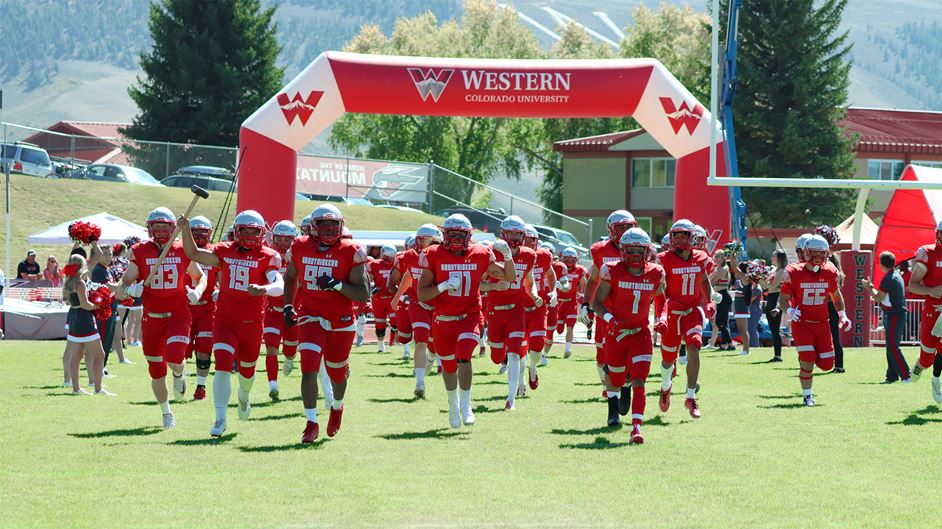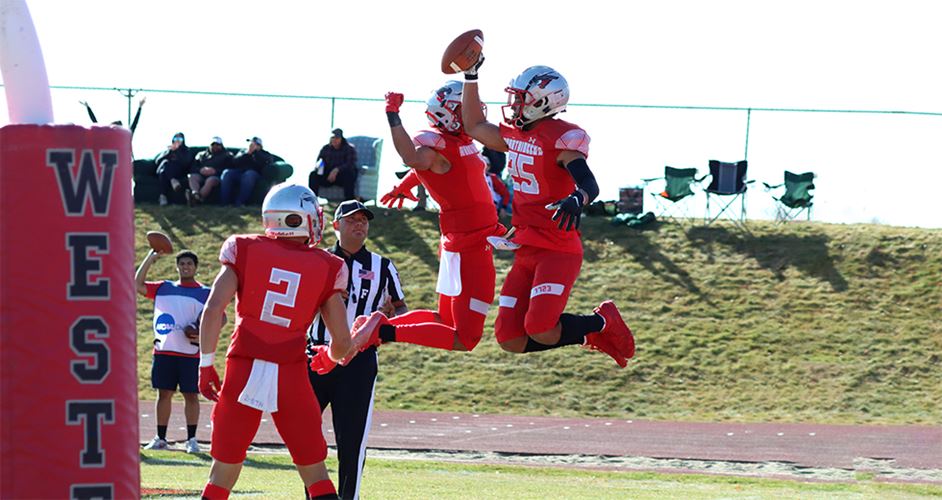
A 14-7 win over Colorado State University Pueblo last Saturday, Nov. 13 crowned the Mountaineers (10-1 Overall, 8-1 RMAC) Rocky Mountain Athletic Conference (RMAC) co-champions with the Colorado School of Mines. It is their 20th conference title and the first since 1998.
On Sunday, The Mountaineers drew the third seed in their Super Region, which features seven teams, and will face sixth-seeded Nebraska-Kearney at the Mountaineer Bowl on Saturday, Oct. 20 at 1 pm. The matchup marks the Mountaineers’ first playoff berth since 1997.
The championship-winning game proved to be a defensive battle. The Mountaineers controlled the game’s pace against the Timberwolves from Pueblo, utilizing more than 36 minutes of game clock and running 69 plays to Pueblo’s 50.
The Mountaineers trusted their ground game, handing the ball off to Redshirt sophomore running backs Josh Cummings and Devyon Butler 33 times for 152 total yards. Cummings led the rushing effort, adding 115 yards and a touchdown to his season totals of 1182 rushing yards and 16 total touchdowns.
Redshirt junior quarterback Connor Desch took seven sacks on the day, but was careful with the football, completing 12 passes with no interceptions for 160 yards and a touchdown on the day. Desch broke the 2,000 passing yard mark against the Timberwolves, and also tossed his 20th touchdown for the season.
Sophomore Buhr key to stout Mountaineer defense
Redshirt sophomore linebacker Wyatt Buhr anchored a staunch Mountaineer defense. Buhr had four tackles, including the Mountaineers’ lone sack and two other tackles for loss (TFLs) Buhr is having himself quite a season in his fourth year in Gunnison, leading the team with 57 total tackles (30 of them solo), two and a half sacks, and nine and a half tackles for loss.
Before arriving at Western, Buhr played for the undefeated state championship La Junta Tigers in La Junta, Colorado, about 60 miles east of Pueblo. Buhr played both linebacker and running back for the Tigers, rushing for more than 900 yards his senior season in 2017-18, and also accounting for 70 tackles as a linebacker.
Buhr remembers his high school coach asking him if he wanted to play football at the collegiate level after the Tigers’ state championship run, a prospect that intrigued Buhr. After he posted a highlight reel, the Mountaineers contacted Buhr and set up a visit in January, in the midst of the wrestling season. Funnily enough, Buhr remembers there was hardly any snow on the ground in Gunnison during his visit.
“When I came up here I loved every bit of it. I’m a big outdoors kind of guy. I came from a small town, and I love small towns,” said Buhr, who enjoys offroading in his Jeep during the winter with his roommate, as well as ice fishing. Colorado State University Pueblo was also in the recruiting conversation, but did not offer Buhr a scholarship. “Western took a shot on me, so I wanted to take a shot on Western,” Buhr said.
Now a redshirt sophomore due to a bonus year of Covid-related eligibility, Buhr is an Exercise and Sport Science (ESS) major with a K-12 Physical Education emphasis. He notes that there is a synergy to studying exercise science while playing for the football team, and that it helps him grasp the science of nutrition and physical training with an eye towards his performance on the football field.
Speaking on the Mountaineers’ wildly successful season, Buhr credits the team’s composure and relaxed but focused attitudes under pressure for the team’s success against Pueblo, and in other big games, like their 23-9 home victory against Colorado Mesa.
Also key to the Mountaineers’ recent slew of successes is the tendency of this team to lift each other up. “When [the] offense is struggling, [the] defense–we look up to the challenge and we accept it,” and Buhr notes that this mentality holds in games where the defense is struggling.
One such example of the offense stepping up to the plate is Western’s 45-38 come-from-behind win on Homecoming against New Mexico Highlands. In that game, Desch was called upon to pass 33 times, totalling 240 passing yards. Cummings rushed for 163 yards and four scores to push the Mountaineer comeback over the top.
In preparation for games, Buhr puts in as many as two or two and a half hours of film study per day during game weeks, watching opponents’ games and working through film packets assigned to players by the Mountaineer coaches (essentially scouting reports for opposing players). This includes identifying formations and plays run by opposing teams, and looking to identify any morsel of relevant information to predict what the offense will do.
“We try to sniff out anything… If they really like this formation on a certain down and distance, say third-and-short, we try to find the little things that give it away, like how far the [running] back is set from the quarterback or different alignments. Sometimes, we’ll even look at the [offensive] tackles to see their stance, to see if it’s a pass or run, because some tackles, they’ll put all their weight on their fingers, and that’s a sign they’re probably gonna run it, and other tackles won’t even touch the ground, they’ll just be in a two-point [stance]; they’re getting ready to stand up and pass protect,” says Buhr.
A final goal for this historic season? Buhr wants to avenge the Mountaineers lone, heartbreaking loss in overtime to the Orediggers from the Colorado School of Mines on Oct. 2. He believes the Mountaineers are more than capable of beating any time they face in the playoffs, so long as the team plays as a cohesive unit and the defense holds its own physically.
Buhr notes that the Antelopes of Nebraska-Kearney, whom the Mountaineers play this Saturday, run an offense based on the triple-option: a style of play utilized predominantly by military service academies in Division-I football due to strict weight requirements for service members, which places a premium on speed and agility. The triple-option scheme makes use of three different “options” to run the ball, with the quarterback able to keep it himself or give the ball to either the fullback or tailback.
This run-heavy style can be a dream for linebackers like Buhr, if they can diagnose the play in time to contain the run. Defending the triple-option can also be a nightmare to figure out which player is keeping the ball.
“Any linebacker loves to play the run, and it should be a physical game…Their quarterback is a really good player,” said Buhr. If the Mountaineers can slow down the Antelopes’ running attack, anchored by their big, physical offensive line, they will likely be in good shape.
Nebraska-Kearney plays in the Mid-America Intercollegiate Athletics Association (MIAA). The Antelopes have found great success on the ground, averaging 264.5 yards per game and 29 touchdowns through 11 games. Their 5.5 rushing average across 532 attempts (compared to just 189 passing attempts) underpins an offense that has hummed along to the tune of 36.3 points per game.
Quarterback TJ Davis is instrumental for the Antelope attack, accounting for more than 1,000 yards on the ground, more than 2,000 through the air, and 37 total touchdowns. Containing Davis is imperative to the Mountaineer game plan. Should the Mountaineers stop Davis and the Antelopes in their tracks, a matchup with either Angelo St. (Texas) or Minnesota-Duluth awaits the following weekend.


